About my works
- How it all begun
- You can't always get what you want (at the first attempt)
- Never forget the good ol' tools
- Not only machinery...
How it all begun
As for any discipline, study and application alone are never enough to light a passion and to master a technique: you need a strong and persistent source of inspiration to give you energy and will. Besides, you often need some fortuitous event to start a chain reaction or to begin to walk a road no deliberate planning would otherwise have pushed you to explore. My ongoing journey through Computer Graphics is a living demonstration of this statements.During all 1997, alternating periods of full pause (so long I often ended up to forget the shortcut keys or even the usage of some tools of my 3D software) to intense but short modeling sessions, I started working on and then left aside tens of objects, often because I used to be a little too presumptuous in choosing the subjects (the typical beginner's mistake) but, above all, because I wasn't sufficiently motivated: among other things, I started a Grendizer head (see below) and I almost completed a whole-figure Getta Robot.
It was when I begun modeling the Eagle of the celebrated TV series Space 1999 that I received a clear warning from ”outside”. I'm sure that a common habit to many modelers is to measure one's skill by choosing uncovered subjects, both to demonstrate to be able to get where no one has yet arrived and to draw neighborhood's attention: so, I was quite absorbed in this job, maybe too content of the result I was seeing along the way, when an issue of a CG magazine fell into my hands where a whole article was devoted to the detailed report of a modeling experience of the same subject I was working on. A cold shower.
I felt I had to get a move: anime Super Robots appeared then to me like a still untouched territory (please note that at that time I didn't have any Internet). I knew I could count on years and years of experience of drawing practise, on a matter that could guarantee an endless supply of subjects and above all on the childish appeal the mighty giants still exert on my fantasy. Nevertheless I couldn't still get started for I had no original model to reference to (probably an excuse to delay the fight).
The first great spark came one Saturday at the end of November 1998 when, walking aimlessly along a side street of a crowed road of Rome, I ran by chance into a little shop selling import anime stuff (comics, model kits, gadgets and so on): I got in and came out with a model kit of Gundam RX-78. To my surprise, once assembled the model revealed to be a high quality and extremely faithful replica of the cartoon's character. That time I had no alibi: I started modeling the robot that very same night.
And that's for the beginning: but no one works for nothing, without getting a minimum of appreciation or without having the chance to submit the achievements to people critics. As I've told elsewhere in these pages, one day I've found several pages of my former site registered on Altavista, a circumstance that gave me unexpectedly the chance to get a rough but concrete estimation of the potential interest the subject could raise among web people. If I didn't proceed previously to any registration, it was uniquely because in my intention that site had to remain a temporary solution, a test experience useful also to get more skilled in using HTML: but having no deadline to observe and especially knowing my temper, I'm sure that if I wasn't ”forced” to come out in the open, that initial phase could have lasted forever.

You can't always get what you want (at the first attempt)
Modeling a complex subject is somewhat like playing a long chess match: you have to possess a solid base theory, develop a specific strategy little by little tailored for your opponent, be trained to mentally anticipate the result of your moves considering your opponent reactions, be patient with the intermediate phases of the game, be creative when tackling new problems and be capable to close the match, eventually resorting to genius, when conditions are all set.An unavoidable consequence of this scenario is that after hours, if not days, of hard struggle to dig out some good stuff, you may risk to feel affection for your “creature“, progressively loosing the faculty to judge coldly your work and ending up to consider what you've done the only result conceivable.
It doesn't happen very often to step back and rebuild from scratch an object you brought to completion and left there as such til that moment: this is especially true when you're modeling something that comes entirely from imagination and doesn't have to be submitted to any check of resemblance or likelihood. But when, as in my case, you are engaged in reproducing a preexisting (and popular!) subject, well, it comes the time when you have to resign, face reality and get to the conclusion that the outcome is totally unsatisfactory: then no regret to get rid of everything and start again.
Following are samples of renderings (fetched directly from my wastepaper basket) witnessing such events: I've made a selection of items illustrating how different, in nature and entity, could have been the reasons that, from case to case, persuaded me to take the painful but necessary decision.
The specification that, out of the two pictures shown for each section, the upper represents the failed attempt, should be superfluous...
Grendizer
In this case, the result, even if partial, was so clearly disappointing from the beginning that it was obvious that no miraculous improvements could ever come along whatever the techniques I would have further used. You can notice that no smoothing is applied and, above all, the work is half-done: I decided almost suddenly to quit and start a brand new try opting for an entirely new approach (spline/metaform instead of simply polygonal).I could define this as an intrinsic, structural failure: I didn't need any model to compare to become aware I had completely missed the target. A not minor cause of the bad result was that I started without a clear decision about how to “interpret“ the robot, whether personally or rather rigorously: as you can see, the chin is oddly shaped while the rest of the object is substantially adherent to the original model.
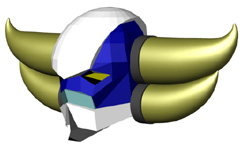
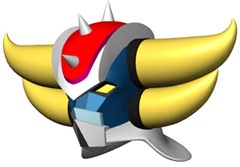
Mazinger Z
A little bit better: this time the influence of Mazinger Z's bigger “brother“, namely the Great Mazinger, that I modeled a couple of days before, had a role in creating this sort of hybrid between the two robots (also because I played it dirty trying to “recycle“ the spline cage I used for the first robot: and I payed). Despite I completed the modeling, the object didn't go through any rendering phase.This is a typical conceptual error: a closer and deeper inspection of the original model convinced me to reject the result: each part of the object has been discarded and re-modeled from scratch.
It could be a trivial advice, but there's nothing better than taking a long break, eventually starting something else in the meanwhile, and then going back to work to bring substantial improvements to your creations. It's like watching the same plant everyday: you don't become aware it's growing till the time you come back to see it after a month you've been away. Many times I've been amazed at the way I looked at objects I made few days before, as if they got out from someone else hands.
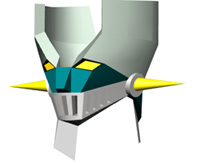
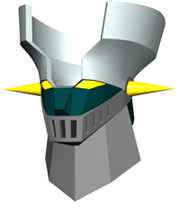
Great Mazinger
A subtler case study: the differences between the two versions are apparently marginal but in my opinion are often details to give the touch of life to your creations. Look at the corner running along the crown, at the front vertical slots of the ”mouth” (they are three, not four) and at the bases of the side horns, which form a continuum with the slotted structure of the chin.I tried some renderings and drew out some final pictures too: it's been only after some weeks of thinking over that I convinced myself that I could have done better than that. Running from an extreme to another, while at the beginning I had to do a big effort to win my laziness to get back to work (nearly from scratch) on something I already “graded” as satisfactory, then I had to force myself to quit when I've seen myself caught in a loop of endless, progressively more insignificant changes (for the record, I'm still puzzled about the crown size).
This time, I saved a couple of parts to start the new modeling from: surely I've recycled all the spline cages.
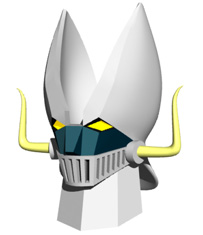
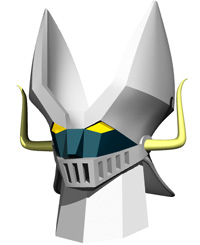
Gundam
No, I'm not trying to make a fool out of you: it's that you can't actually see any apparent difference between the two samples (except few negligible details I challenge you to find out), unless you dive into the statistics of points and polygons or try some rendering of the head close-ups (cheese!) with shading effects turned on.This is maybe the worst case, a real blow under the belt: you are sure to have put up a great piece but when you go rendering the whole thing you discover awful effects (I call it "the lace's shadow") on your model's surfaces. In few words, I had chosen not to triple some surface to preserve the (illusory) smoothness I reached after tens of attempts. That's what I call a technical mistake only experience can teach you how to beware of.
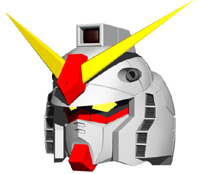
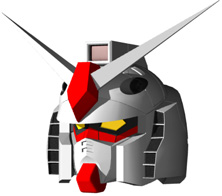

Never forget the good ol' tools
Following my experience, a basic premise to succeed in obtaining high quality objects is to sketch them on paper, at least for some details, before starting any modeling process: I've found this a good method to develop ”confidence” with the subject I'm about to reproduce, in order to foresee and anticipate the most difficult passages of the work. No need to say that the best precondition to achieve a good result in little time is to start with the object already ”sculpted” in your mind: such a practice is moreover of great help in figuring out the best modeling tool for each part or detail I happen to manage with from time to time.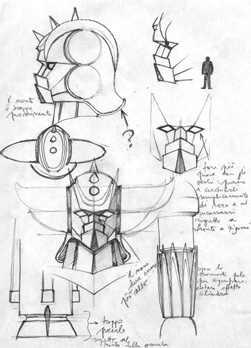
Setting exact angles or coordinates when modeling some detail of an object is certainly a boring activity, conflicting with instinct and creativity: I have no problems in admitting that in my works approximation and asymmetry are ubiquitous. Yet, especially when articulating arms and legs or any other part dynamically bound to another one, I've frequently missed a more careful setting of surface curvatures and pivot point positions: these are probably the times when a more substantial attention to metrics is required and the use of CAD techniques and procedures would pay back later a considerable save of time.
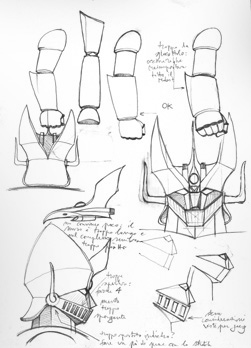
Other robots instead, like Gundam, leave few room to ”free initiative”, having their profiles and lines far more established and ”officially” defined. If you happen to have a ride through the many sites featuring pics of 3D models of Gundam, you would probably notice, leaving aside the artistic quality of meshes and renderings, little differences between the various versions of the robot, being consequently hard to even track and recognize the personal style of each artist. With this respect, having at hand detailed pictures of robots of this kind, is of crucial importance to obtain good results.
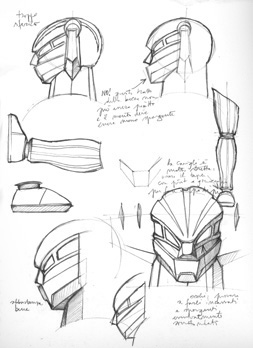
I have little idea of methods and customs used by other 3D modelers, but I suppose that the use of traditional, “warm” techniques is anyway a step no one can still afford to ignore: that's probably because this is after all yet a transition age, whose 3D artists, stem from the recent availability of affordable and powerful HW and SW instruments, still have a strong classic background.
Probably the next generation, coming from a social and cultural context where the use of computers will have been accepted and taught as a way of expression as current as speech or writing, will naturally perform 3D modeling as a native, direct language, having totally skipped any form of ”fine arts” apprenticeship: honestly I don't know if that will be a good day.

Not only machinery...
Images gathered in these pages indisputably form a monothematic collection, i.e. there's very few beyond representations of robots, aircrafts and spaceships taken from the very specific anime sphere. The lack of suitable backgrounds or human presence is perceivable quite everywhere and, as far as the global feeling delivered to the viewer is concerned, it becomes a serious drawback when, browsing tens and tens of pictures of robots portrayed in a wide variety of poses, you slowly loose the perception to be dealing with objects meant to be gigantic, ending up to instinctively apply the same aesthetic criteria of judgement you would use for a human subjects. Besides, abstracting these characters from any real life context and letting them floating in the void, vanishes one of the main reason of the whole work, that is providing the illusion of true existence to objects no one's ever see in the real world (would Jurassic Park's T-Rex have looked so real alone on a blank page?).; Natural backgrounds are sometimes used in some scenes but they're nothing more than bitmaps: it would be great to have actual, three-dimensional environments the giant robots, for instance, could interact with (through shadows, proportions, perspective, light and atmospheric effects, to say a few) but it would cost to me a tremendous overhead of work and it's certainly a topic I'm not skilled in. Since each software has its own highlights and specific field of best effectiveness (a killer application is far from being seen), I'm seriously thinking about the possibility to start using one of the several ”world builders” on the market, affordable but yet sophisticated programs capable to produce breath-taking landscapes with few settings and in a couple of seconds. It would be a great deal to me even if I'd limit their use as bitmap generators, considering the time I actually waste in getting hardly acceptable pictures (not to mention the cost of buying tens of CD-ROMs most of the times filled up with thousands of poor quality photos).
Artificial environments as buildings, roads, generic infrastructures or other mechanical items like airplanes, motor vehicles and so on, make a case on their own: requiring maybe still more resources than natural backgrounds, this time no programs exist (as far as I know) to help you serialize the production of, say, skyscrapers, trucks or hangars (though many collection of meshes are available offering a broad choice of ready-to-use objects). That's a pretty bad luck because it's just nearby large objects, or better sets of large objects, whose depth, width and length we're able to estimate and ”feel” at a glance that characters tens of meters tall like Grendizer would cause the best impression. I tried to make up some stuff but I confess I gave up quite immediately, not even knowing exactly what to do.
Last but definitely not least, few words about human beings. Probably the best term of comparison to fully appreciate the physical size of Gundam & Co. and at the same time to bring them closer to reality, would be represented, for instance, by their own pilots depicted near them or, even better, inside them sit at their battle stations. What a scene it would be to see a squad of technicians working on Gundam to set it for a battle or a cheering crowd surrounding Mazinger Z after a great victory (against a haunting sunset: a classic).
Still limiting our attention to the anime universe, we have a double, treacherous challenge. Firstly, reproducing human characters undoubtedly represents the most ambitious task for the 3D modeler but also the one capable to dispense the worst delusions and frustrations: in a sense, it's something that, once started, leaves you no choice but to get to the end of the job and refuse any compromise. A human subject can't be ”partially” realistic: you hit the target or you miss it at all. Obviously things like textures, bump mapping and effective lighting give a critical contribution to the overall outcome but correct anatomy, authentic facial expressions and in general a specific style able to avoid the dummy look & feel of wireframe objects weight for the 90%. For these kind of things, as far as I know, no magic tools exist to lighten the work: it' just you against points and polygons.
Secondly, as already stressed in these pages, reproduction of anime subjects entails the translation of something created in a 2D world into ”real” (I know, it may raise a smile) entities. Considering the oversimplified, conventional canons typical of the Japanese artists, this can be viewed as an advantage: I think instead that the unmistakable anime drawing style may end up to be a trap, representing a strong temptation to adopt its guidelines and to create a sort of hybrid characters, half human and half cartoon, bringing no benefits to the ”struggle for likelihood” and shadowing modeler's creativity. On the other side, (but this could be a paradox) electing realism as the only measure of quality for these kind of subjects would perhaps spoil the magic (if any) surrounding characters born and grown in a universe apart: after all, if your only curiosity is to get an impression of what, say, Duke Fleed would have looked like in real life, you could always get a photo of someone dressed like him. Probably there has to be a ”third way”, an alchemy that I can't explain, able to reconcile the two points of view.
The knowledge and passion I'm currently converting and renewing into Computer Graphics comes from years and years of thorough practise in reproducing human anatomy and facials: a wealth of experience that cannot be thrown away and must exploited. Let's say that I'm already working in this direction...


